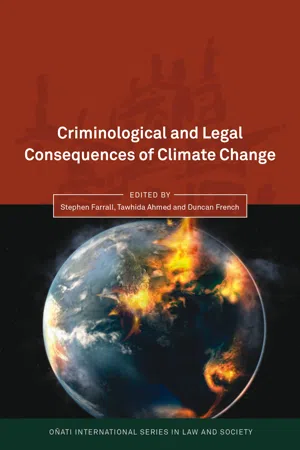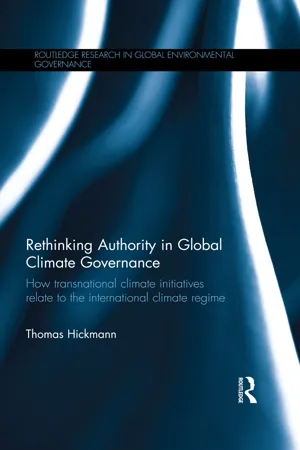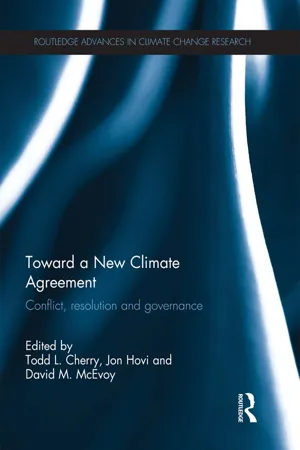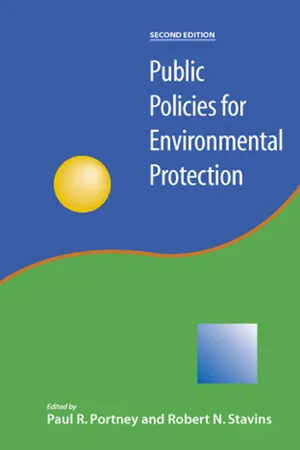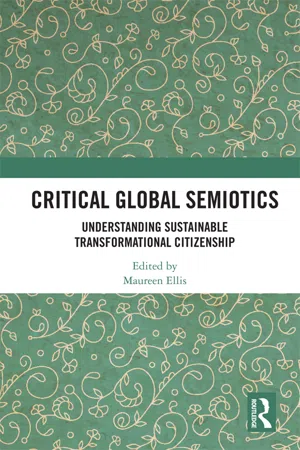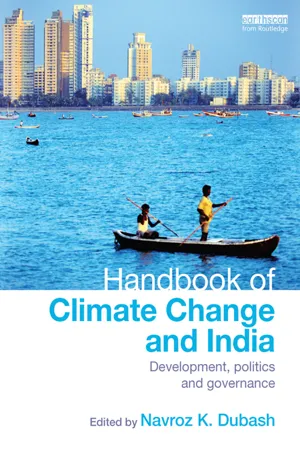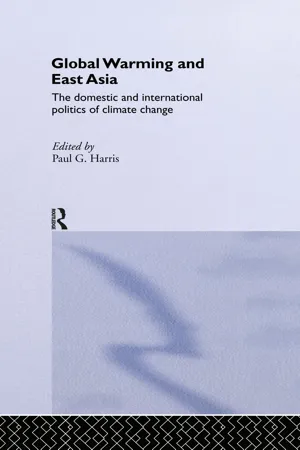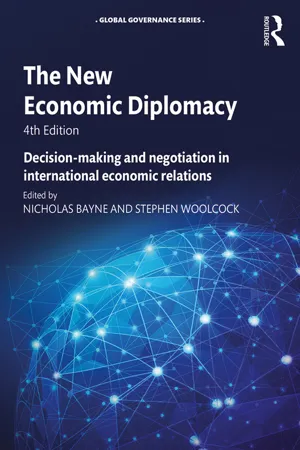Politics & International Relations
International Climate Change Agreements
International climate change agreements are global treaties that aim to address the challenges of climate change through coordinated efforts among participating countries. These agreements typically involve commitments to reduce greenhouse gas emissions, promote sustainable development, and provide financial and technological support to developing nations. Key examples include the Kyoto Protocol and the Paris Agreement.
Written by Perlego with AI-assistance
Related key terms
Related key terms
1 of 4
Related key terms
1 of 3
11 Key excerpts on "International Climate Change Agreements"
- eBook - ePub
- Paul G. Harris(Author)
- 2009(Publication Date)
- Routledge(Publisher)
1 Climate change in environmental foreign policy Science, diplomacy, and politics Paul G. Harris Over the past three decades, climate change has moved from being a minor, mostly scientific, matter in the affairs of states to being a prominent, front-burner foreign policy priority. It is also now a major concern of international organizations, industry, nongovernmental organizations (NGOs) and a growing number of people around the world. As climate change has grown in prominence among other foreign policy priorities, so too have predictions of its adverse impacts on nature and societies. Indeed, many of the effects are being felt today. Governments have negotiated agreements to study climate change and, in the case of many developed states, to start limiting the pollution that causes it. However, their responses to the problem have failed to keep up with the increasing pace of climate change; they are grossly inadequate. Why this lackluster response to what is likely the greatest problem yet faced by humanity? In this book we aim to help answer this important question by examining the policies of a variety of states from both the developed and developing worlds. Our main aims are: (1) to analyze the politics of climate change within and among states; and (2) to supplement existing knowledge of climate politics by focusing on the actors and processes of foreign policy. A premise underlying our work is that analyzing and thinking about climate change from the perspective of foreign policy — the crossovers and interactions between domestic and international politics — will help us to better understand how and why governments have responded the way that they have - Stephen Farrall, Tawhida Ahmed, Duncan French, Stephen Farrall, Tawhida Ahmed, Duncan French(Authors)
- 2012(Publication Date)
- Hart Publishing(Publisher)
2 The ‘multilateral climate change regime’ is understood here as referring to the 1992 UN Framework Convention on Climate Change (UNFCCC), the 1997 Kyoto Protocol and associated institutions, decisions, processes and legal agreements subsequently negotiated. It must also incorporate an understanding of the political, policy and scientific debates which are part-and-parcel of the climate change regime, thus including both the work of the Intergovernmental Panel on Climate Change (IPCC) and the elaboration of such political texts as the 2009 Copenhagen Accord.3 This is a general issue for international environmental law, on which P Birnie, A Boyle and C Redgwell, International Law and the Environment , 3rd edn (Oxford, Oxford University Press, 2009) 3: ‘“international environmental law” is of course different from international human-rights law, the law of the sea, natural resources law, or international economic law, inter alia, but there are significant overlaps and interactions with these categories, and the categorisation is in some cases a matter only of choice and perspective ’. Emphasis added.4 For a very good example of this, see L Godden, ‘Death, Desire, Modernity and Redemption: Climate Change and Public International Environmental Law’ (2009) 10 Melbourne Journal of International Law- eBook - ePub
States of Knowledge
The Co-Production of Science and the Social Order
- Sheila Jasanoff, Sheila Jasanoff(Authors)
- 2004(Publication Date)
- Routledge(Publisher)
The historical evolution of climate change as a public policy issue exemplifies the problem. In a speech to the Second World Climate Conference in November 1990 (see quote at the beginning of this chapter), Mostafa Tolba, then Executive Director of the UN Environment Programme (UNEP), highlighted new scientific evidence for global warming and called for worldwide action to combat the problem. Tolba imagined a new, worldwide political order of unprecedented scope that could affect, as he put it, “every individual on the planet”. The following month, the UN General Assembly authorized the formation of a new international institution – the Intergovernmental Negotiating Committee – to develop an overall framework for global policy responses to climate change. Eighteen months later, at the 1992 UN Conference on Environment and Development in Rio de Janeiro, Brazil, the Committee completed the UN Framework Convention on Climate Change. The treaty, ultimately signed by over three quarters of the world’s countries, established a suite of permanent global institutions to make global climate policy, and began the process of determining the norms and practices that would govern those institutions.Tolba’s views typify contemporary perspectives that link the global politics of climate to scientific understanding of the issue. They depart noticeably, however, from earlier framings of climate change. The claim that climatic changes will result from carbon dioxide buildup in the atmosphere has a long history. Nevertheless, prior to the late 1980s, scientists and other policymakers rarely connected this idea to a need to reorganize global politics. Why not? I will argue in the following two sections that they did not make these connections in part because, until recently, they represented and articulated their understandings of the atmosphere primarily in local and regional, not global, terms. Only when the Earth’s climate was re-imagined as a global - eBook - ePub
Rethinking Authority in Global Climate Governance
How transnational climate initiatives relate to the international climate regime
- Thomas Hickmann(Author)
- 2015(Publication Date)
- Routledge(Publisher)
Soroos 1994; Zürn 1998). In the years following this conference, the number of international environmental agreements increased considerably and the prescriptive character of many agreements has since then also been strengthened. However, the problem of climate change was not a prominent topic at this conference and did not receive much attention in the conference report (United Nations 1972). Only after scientific evidence grew in the 1980s showing that the earth was warming due to an increased concentration of GHG emissions in the atmosphere was the matter taken up as an international political concern. The United Nations Environment Programme and the World Meteorological Organization played an important role in fostering scientific consensus on the problem of climate change. In response to new findings on the problem of climate change, these two organizations convened a number of workshops and conferences and jointly established the Intergovernmental Panel on Climate Change (hereafter IPCC) in 1988 to conduct assessments of the current state of scientific knowledge on climate change. 1 Two years after its foundation, the IPCC released its First Assessment Report stating that human activity was leading to rising atmospheric GHG concentrations and an increase in the earth’s global mean surface temperature by about 3° Celsius before the end of the next century (IPCC 1990). The report was endorsed by scientists and politicians at the Second World Climate Conference held in Geneva, at which nation-states agreed to adopt a Ministerial Declaration recommending that negotiations towards a framework convention on climate change should begin without delay (Jäger and Ferguson 1991). Thereupon, the United Nations General Assembly formally started the negotiation process towards an international climate treaty by establishing the Intergovernmental Negotiating Committee, which met six times between February 1991 and May 1992 - eBook - ePub
Toward a New Climate Agreement
Conflict, Resolution and Governance
- Todd Cherry, Jon Hovi, David M. McEvoy(Authors)
- 2014(Publication Date)
- Routledge(Publisher)
Oran R. Young IntroductionProvisions pertaining to fairness or equity are prominent features of international environmental agreements. The 1992 United Nations Framework Convention on Climate Change (UNFCCC), for instance, states that “[t]he Parties should protect the climate system for the benefit of present and future generations of humankind, on the basis of equity” (UNFCCC 1992 Art. 3.1). The 1997 Kyoto Protocol to the UNFCCC seeks to put this provision into operation through the adoption of the principle of common but differentiated responsibilities, which distinguishes between developed (UNFCCC Annex I) and developing (UNFCCC non-Annex I) states with regard to targets and timetables for reducing greenhouse gas (GHG) emissions, and through the inclusion of a commitment to devising measures to protect particularly vulnerable societies, such as small island developing states (Kyoto Protocol 1997). Even the 2009 Copenhagen Accord, widely regarded as a political statement cobbled together following a failure of the Conference of the Parties to the UNFCCC to agree on the terms of a new legally binding agreement on climate change, states clearly that “[w]e shall … on the basis of equity and in the context of sustainable development, enhance our long-term cooperative action to control climate change” (Copenhagen Accord 2009).There is nothing unusual about the case of climate change in these terms. Similar statements appear in agreements relating to other large-scale environmental problems. For their part, practitioners devote considerable attention to the challenge of crafting provisions that the parties to such agreements are prepared to accept as fair or equitable. Yet social scientists, and especially those whose expertise is rooted in political science and economics, regularly argue that the influence of such considerations is marginal in the creation of such agreements. A typical formulation comes from David Victor, a prominent commentator on issues relating to climate change, who asserts that “for most states most of the time, the decision making process is mainly a selfish one. Consequently, there exists very little evidence that fairness exerts a strong influence on international policy decisions” (Victor 1996: 3; see also Victor 2011). - eBook - ePub
- Paul Professor Portney, Robert N. Professor Stavins, Paul Professor Portney, Robert N. Professor Stavins(Authors)
- 2010(Publication Date)
- Routledge(Publisher)
Because the source of the risk is widespread, responsibility for resolving the problem ultimately must be shared. But the more widespread the responsibility, the greater the challenge of maintaining a stable agreement, because nations have more incentive to free ride on the actions of other nations. This challenge is compounded by national differences related to income, vulnerability to climate change, and capacities to respond. Two related elements of cooperative and noncooperative economic behavior underlie the numerous intricacies of international diplomacy aiming to design and implement a climate agreement: the paradox of international agreements and the engagement of developing nations.The Paradox of International Agreements
The problem of achieving effective and lasting agreements can be stated simply: A self-enforcing deal is easiest to close when the stakes are small, or when no other option exists (a clear and present risk). Nations have a common interest in responding to the risk of climate change, yet many are reluctant to reduce GHG emissions voluntarily. They hesitate because climate change is a global public good—no nation can be prevented from enjoying climate protection, regardless of whether it participates in a treaty. Each nation’s incentive to reduce emissions is thus limited because it cannot be prevented from enjoying the fruits of other nations’ efforts. This incentive to free ride reflects the divergence between national actions and global interests.No global police organization exists to enforce an international climate agreement. As such, an agreement must be voluntary and self-enforcing—all sovereign parties must have no incentive to deviate unilaterally from the terms of the agreement. But a self-enforcing agreement is hardest to achieve in the gray area between low and infinite stakes. By free riding, some nations can be better off refusing an agreement. The greater the global net benefits of cooperation, the stronger the incentive to free ride; therefore, a self-enforcing agreement is harder to maintain. A self-enforcing agreement is most easily maintained when the global net benefits are not much bigger than no agreement—hence, the paradox. For more discussion, see Hoel 1992; Carraro and Siniscalco 1993; Barrett 1994; and Bac 1996. - eBook - ePub
Critical Global Semiotics
Understanding Sustainable Transformational Citizenship
- Maureen Ellis(Author)
- 2019(Publication Date)
- Routledge(Publisher)
Chapter 5Political economy and cultural politics of international trade and climate change negotiations
Kishor DereIntroduction
This chapter applies legal semiotics and critical realism lenses to high expectations and actual outcomes of the UN Framework Convention on Climate Change’s (UNFCCC) 24 Conferences of Parties (COPs), held from 1995 to 2018, and the World Trade Organisation’s (WTO) 11 Ministerial Conferences (MCs) (1996 to 2017). In both the marathon negotiations, there have been sharp differences between the global north and the global south in spite of the realization that multilateralism should be promoted. UNFCCC COPs, held until 2018, are yet to come out with a sturdy plan of action to effectively combat the green-house-gas (GHG) emissions. Likewise, WTO MCs, held until 2017, are yet to address the principal concerns of the vast majority of the world population living in developing and least developed countries over fair trade, non-agriculture market access, whopping agricultural subsidies provided to prosperous farmers in the US and Europe, and the Doha “Development” Agenda.Both the negotiating conferences appear to be high on rhetoric and low on performance. Law and justice seem to have become estranged cousins. Here international environmental and climate justice, in the first case, and international trade law and economic justice, in the second case, do not seem to see eye to eye.24 UNFCCC COPs (1995–2018) to combat climate change
The United Nations Framework Convention on Climate Change (UNFCCC) was signed at the United Nations Conference on Environment and Development (UNCED) or Earth Summit held at Rio de Janeiro, Brazil, in 1992. The UNFCCC came into force on 21 March 1994. It set in place the internationally recognized principle that green-house gas (GHG) emissions should be set at a level that would not interfere with the planet’s climate (Berlin Mandate website). Most negotiators in the UNFCCC COPs (UNFCCC website) seem to be oblivious to the fact that primarily it was science that brought them to these meetings. The climate science, however, is relegated to a show piece in a museum, and it becomes a commodity the negotiating customers could take or leave depending upon their subjective understanding of their respective national requirements. The climate scientists have a valid reason to feel frustrated, because the valuable evidence gathered by them is neglected or even sacrificed on the altar of political and economic expediency. Science unambiguously presents the world with an assessment of risk. It tells the readers in no uncertain terms that climate change is the “defining challenge of our times”, as the UNFCCC executive secretary Christiana Figueres pointed out in the run-up to the 2010 meeting in Cancun. She added that in the climate change negotiations, the long-term sustainable future of humanity was at stake. The goalpost set up by the science needs a full-fledged energy revolution not only in terms of its production and distribution but also in terms of its consumption. Figueres believes that this goal can be accomplished only if nations grasp “the politically possible at every step” (Marsden, 2012: 11). - eBook - ePub
Handbook of Climate Change and India
Development, Politics and Governance
- Navroz Dubash, Navroz Dubash(Authors)
- 2012(Publication Date)
- Routledge(Publisher)
realpolitik considerations, of course, is also the very real fact that India cannot afford to ignore the emergence of new scientific evidence on climate change, and the pressing question of its own vulnerability. Equally, it cannot afford to ignore domestic voices that may be at variance with its traditional stance on this issue, or even critical external views (see Huq and Metz, this volume, for instance), especially if these are driven by better and more legitimate arguments, and a genuine concern for India’s long-term welfare and interests. As international climate negotiations enter a new and uncertain phase, India thus faces a complex array of choices and trade-offs on this issue. What is vital is that these choices and trade-offs are made in an intelligent, balanced and reasoned manner, based on widespread consultation and the best available evidence, rather than on either dogma or whim.If India’s national interest on climate change is to be best served, then it must combine aggressive domestic action to combat climate change with tough and cleareyed bargaining in its international negotiations. Equally, as it attempts to play a new ‘bridging role’ between the North and South, India needs to manage its various alliances, old and new, in a sensible manner, based obviously on its own interests, but also keeping in mind its professed values of securing a fairer international order that will protect weaker nations against the strong. However, in the ultimate analysis, any decision that India takes on climate change will be judged primarily by how much and how quickly it enables the country to leapfrog to a smarter, sustainable and technologically superior developmental pathway that advances the future well-being and prosperity of all its citizens, and enhances the overall security and prestige of the country. It is these criteria that should guide it forward on this issue.Notes
1 The author would like to thank the editor and other contributors to this volume for their valuable feedback.2 Under ‘emissions trading’, developed countries are permitted to buy and sell excess emission allowances from each other to help meet their Kyoto targets. Under ‘joint implementation’ they are allowed to invest in emission reduction projects in other developed countries and gain credits in exchange to help meet their own targets. Under the ‘clean development mechanism’, they are allowed to gain credits by investing in emission reduction projects in developing countries. For more details, see: http://unfccc.int/ - eBook - ePub
- Paul G. Harris(Author)
- 2004(Publication Date)
- Routledge(Publisher)
reactive to proactive , and that this change is related to changes in Japanese foreign policy. Hosting COP3 in Kyoto had a significant effect in involving foreign policy perspective in the climate change debate. Before negotiations for the Kyoto Protocol started, Japan tended to consider climate change as an environmental or energy issue. During the negotiations, however, Japan began to see climate change as a foreign policy matter. This change influenced Japan's positions during and after the negotiation on the Protocol.Japan's position on climate change will continue to be influenced by foreign policy process. Its greater willingness to be involved in the international debate is likely to continue if its involvement at the international level remains the same as it is today. The converse is plausible, however, if its role at the international level changes.Japan's decision-making on the climate change debate
Phase 1 (1985–1989):before dawn
Not many Japanese people, either policymakers or the public, were aware of climate change during this period. Some Japanese scientists were engaged in research on climate change, but most were studying the mechanism and impact of climate change, not policies to prevent or mitigate it. Scientists made little effort to motivate Japanese policymakers (see Chapter 9 ). However, at the international level, researchers gradually started to press policymakers to act. Scientists and policymakers convened in Villach, Austria, in 1980, 1983, 1985, and 1987, and in Bellagio, Italy, in 1987 (Jäger and O'Riordan 1996: 12–21). These conferences bore fruit in June 1988, when the World Conference on Changing Atmosphere was held in Toronto, Canada. The Conference called on all developed countries to cut their Carbon dioxide (CO2 ) emissions by 20 percent from 1987 levels by 2005.A very large group of scientists, the Intergovernmental Panel on Climate Change, was established a few months after the Toronto Conference. Japanese scientific experts who attended or heard of the meeting became aware that climate change was likely to become a political issue before long. Similar awareness was raised in Japan's prime minister: During the Toronto Summit Conference in June 1988, Prime Minister Noboru Takeshita was said to have been surprised to find other participants discussing global environmental issues.1 - eBook - ePub
The New Economic Diplomacy
Decision-Making and Negotiation in International Economic Relations
- Nicholas Bayne, Stephen Woolcock, Nicholas Bayne, Stephen Woolcock(Authors)
- 2016(Publication Date)
- Routledge(Publisher)
Federal Court Affirms Constitutional Rights of Kids and Denies Motions of Government and Fossil Fuel Industry in Youth’s Landmark Climate Change Case . Available at: http://www.ourchildrenstrust.org/event/740/breaking-victory-landmark-climate-case.Panagariya, A. 2001. Developing Countries at Doha: A Political Economy Analysis . Policy paper, University of Maryland. Available at: http://www.columbia.edu/~ap2231/Policy%20Papers/Doha-WE-2.pdf .Rittel, H.W.J. and Webber, M.M. 1973. Dilemmas in a General Theory of Planning. Policy Sciences , 4, 155–169.Schiermeier, Q. 2015. Courts Weigh in on Climate Change. Nature , 523, 18–19.Shishlov, I. and Morel, R. 2016. Compliance of Parties to the Kyoto Protocol in the First Commitment Period. Climate Policy , 16(6), 768–782.Singh, M. 2009. Intervention by Prime Minister Manmohan Singh on Climate Change. Commonwealth Heads of Government Meeting (CHOGM) Summit, Port of Spain, Trinidad and Tobago. Available at: http://intellibriefs.blogspot.co.uk/2009/11/science-must-not-trump-equity.html .Swim, J. et al. 2009. Psychology and Global Climate Change: Addressing a Multi-Faceted Phenomenon and Set of Challenges. Report of the American Psychological Association Task Force on the Interface between Psychology and Global Climate Change . Available at: http://www.apa.org/science/about/publications/climate-change.aspx .Terhalle, M. 2015. The Transition of Global Order: Legitimacy and Contestation . Basingstoke: Palgrave Macmillan.UNEP. 2015. The Emissions Gap Report 2015: A UNEP Synthesis Report . Nairobi: UNEP. Available at: http://uneplive.unep.org/media/docs/theme/13/EGR_2015_301115_lores.pdf .UNFCCC. 1992. The United Nations Framework Convention on Climate Change . Available at: www.unfccc.int .UNFCCC. 2009. The Copenhagen Accord: Addendum to Decision 2/CP.15. Report of the Conference of the Parties on Its Fifteenth Session, Held in Copenhagen, from 7 to 19 December 2009. FCCC/CP/2009/11/Add.1. Available at: www.unfccc.int .UNFCCC. 2010. Decision 1/CP.16: The Cancun Agreements. Report of the Conference of the Parties on Its Sixteenth Session, Held in Cancun from 29 November to 10 December 2010. FCCC/CP/2010/7/Add.1. Available at: www.unfccc.int - eBook - ePub
Climate Change and International History
Negotiating Science, Global Change, and Environmental Justice
- Ruth A. Morgan(Author)
- 2024(Publication Date)
- Bloomsbury Academic(Publisher)
19In the wake of July’s Exxon Valdez oil spill off the Alaskan coast in 1989, the Group of Seven (G7) nations met in Paris, where rising inflation was a cause for concern. Nevertheless, leaders of the seven major industrialized countries gave environmental issues, such as the ozone layer and climate change, new political impetus, devoting eight pages of the meeting’s 22-page communique to such questions. Endorsing “the concept of a framework or umbrella convention on climate change,” they expressed their support for the work that the IPCC had been undertaking and emphasized their commitment to ensuring the “compatibility of economic growth and development with the protection of the environment.”20Climate change likewise entered international conversations among the political leaders of the developing world. At July’s South Pacific Forum in Kiribati, delegates drew attention to the implications of rising sea levels for their island countries, which the Commonwealth Secretariat echoed in its October Langkawi Declaration.21 At the Belgrade meeting of the Non-Aligned Movement in September, leaders agreed to call “for the preparation and adoption of an international convention on the protection and conservation of the global climate on an urgent basis.” India’s prime minister, for his part, also advocated for a Planet Protection Fund under UN control. By year’s end, it had become evident to Woods Hole director Woodwell and his colleague Kilaparti Ramakrishna that “some of the developing nations wish to join the global warming dialogue because they see opportunities for increasing their economic development, while others see a compelling need to find appropriate solutions to arrest global warming because of their fragile geographic and economic situations.”22
Index pages curate the most relevant extracts from our library of academic textbooks. They’ve been created using an in-house natural language model (NLM), each adding context and meaning to key research topics.
Explore more topic indexes
Explore more topic indexes
1 of 6
Explore more topic indexes
1 of 4

